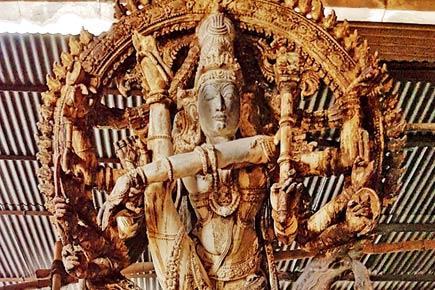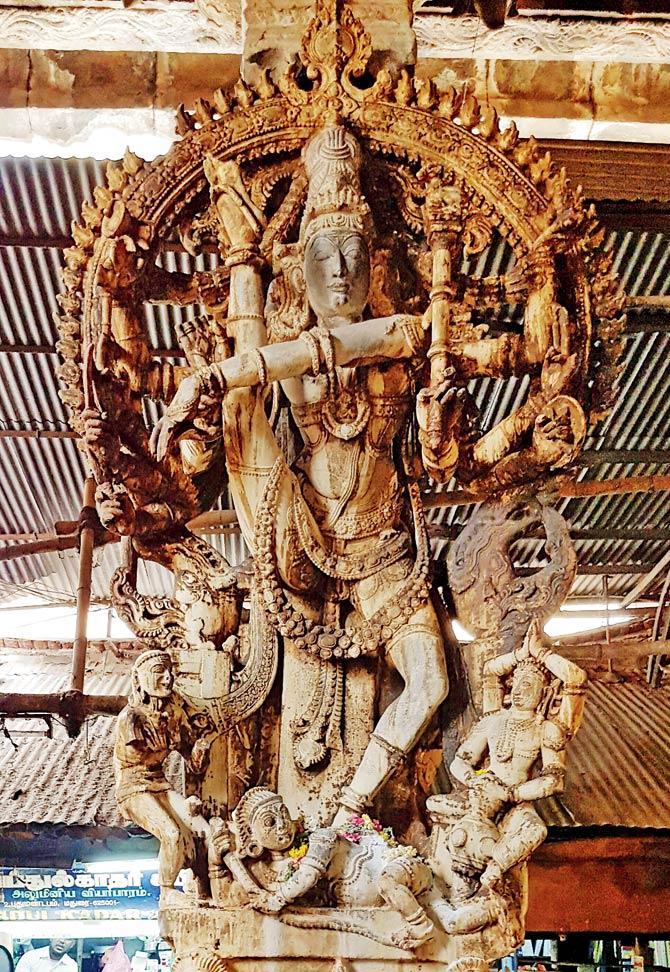I spent a few days last week in the company of gods and goddesses, who were up to all kinds of stuff


Shiva strikes the ‘oortha thandavam’ dance pose, with upraised leg, at the Madurai Meenakshi temple. Pic/Sarayu Kamat
 I spent a few days last week in the company of gods and goddesses, who were up to all kinds of stuff. For instance, Shiva and Parvati had been competing in a dance reality show at Chidambaram, in Tamil Nadu. Shiva struck an “oortha thandavam” pose, raising his foot above his head. Parvathi, dressed in a sari, and too modest to want to match this, lost the competition. Legend has it that she was so furious at being unjustly defeated, that she turned into Kali and stormed out; her Thillai Kali temple still stands on the outskirts of Chidambaram, where she was once depicted in chains, to contain her rage. Can any contemporary TV dance reality show drum up more drama than these two contestants?
I spent a few days last week in the company of gods and goddesses, who were up to all kinds of stuff. For instance, Shiva and Parvati had been competing in a dance reality show at Chidambaram, in Tamil Nadu. Shiva struck an “oortha thandavam” pose, raising his foot above his head. Parvathi, dressed in a sari, and too modest to want to match this, lost the competition. Legend has it that she was so furious at being unjustly defeated, that she turned into Kali and stormed out; her Thillai Kali temple still stands on the outskirts of Chidambaram, where she was once depicted in chains, to contain her rage. Can any contemporary TV dance reality show drum up more drama than these two contestants?
ADVERTISEMENT
In fact, I’d been watching films back to back for the Berlin and Dubai film festivals for some months, and needed a short break. My sister Sarayu invited me to join her and her friends on a Pancha Bhoota tour of temples evoking Lord Shiva through the five elements — Nataraja at Chidambaram (sky/ether), Arun-achaleshwar at Thiruvannamalai (fire), Ekambareshwar at Kanchipuram (earth), Jambukeshwar at Thiruvanaikaval (water) and Kalahasti Vayu Linga (wind; which I missed). In fact, we did many more temples, including the spectacular Brihadisvara temple in Thanjavur, exquisite Airavatesvara temple at Darasuram and goddess Meenakshi’s temple at Madurai. Having done a superb course in Indian philosophy and aesthetics at Jnanapravaha, Sarayu and I were now seeing temples with new eyes.
As I said, we saw all kinds of stuff. At the Jambukeshwar temple, for instance, the priest — a short, old man with a white stubble, does a daily ritual at around 12 noon, going around the temple dressed as a woman, in a flaming red silk sari, quite matter-of-factly before doing the puja. He also wears a red crown, is preceded by musicians, and postceded by a man with a danda who keeps the crowds at bay. The story goes that Goddess Parvati, known in this temple as Akhilandeshwari, was sent by Lord Shiva to do penance on earth. She had offended the Lord, and to win back his affection, she worshipped an “Appu Lingam” made of water. Symbolically, therefore, the priest enacts the puja on her behalf.
Sarayu’s friends Yamini and Bamini, trained in classical Carnatic music, sang prayers at most of the temples we visited, and Vishakha danced for Nataraja at Chidambaram. There’s something very beautiful about women who spontaneously and with a confident voice, sing ancient prayers in centuries-old Indian temples that are bustling with devotees, yet are oblivious to everything, except god. It was deeply moving, transforming a usually push-and-shove experience into a transcendental one.
There was such a lot of love going on. At the Adi Varaha temple at Mahabalipuram, there was a wonderful sculpture of a blue boar nuzzling a stunning woman. The visual might ordinarily have repelled. But, of course, it was Vishnu as Varaha (boar), who hugged Bhudevi, the earth goddess, having saved her from the primordial waters; one hand lovingly embraced her body, the other was placed on her leg.
At the Madurai Meenakshi temple, Meenakshi holds a parrot, symbol of Kama, god of love. We witnessed a nightly ritual: Meenakshi is the boss here, so the utsav murti (festival image) of her husband Sundareshwara (Shiva) is ceremonially carried to her private chambers on a palanquin. The priests place both the utsav murtis on a swing in a room full of fragrant jasmine, whose walls are covered with mirrors. With the encouragement of priests, and devotees milling outside, the divine couple finally heeds the parrot.
The boar and parrot were not the only creatures we met. At the Adi Varaha temple, the priest had clapped three times before opening the temple door, to request resident snakes to take a short break while we pottered about inside. Finally, Yamini sang the Ekdant prayer for Akhila, the temple elephant of Akhilandeshwari at Jambukeshwar. I don’t think anyone had ever sung for Akhila before; she considered the song offering, fluttered her long lashes, then joyously proceeded to demolish her breakfast — a few banana trees.
Meenakshi Shedde is South Asia Consultant to the Berlin Film Festival, award-winning critic, curator to festivals worldwide and journalist. Reach her at meenakshishedde@gmail.com.
 Subscribe today by clicking the link and stay updated with the latest news!" Click here!
Subscribe today by clicking the link and stay updated with the latest news!" Click here!







